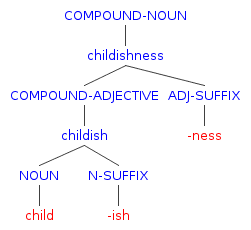Altmetric
Monday, January 7, 2013
Pronunciation Survey
Please give me your opinion about this semester's class here.
Posted by
Mr. Matthews
at
3:30 PM

Pronunciation Survey
2013-01-07T15:30:00+08:00
Mr. Matthews
Comments
Sunday, January 6, 2013
Compound Words Made of a Root & More Than One Prefix or Suffix
Compound
Words Made of a Root & More Than One Prefix or Suffix
Some compound
words are made of a root (stem) and more than one prefix or suffix.
A compound
adjective is an adjective made of two or more morphemes. A compound noun is a noun made of two or
more morphemes. Examples:
1 NOUN childishness = ADJECTIVE childish + NOUN SUFFIX -ness
 |
| childishness (morphological tree diagram) |
childishness -- [COMPOUND-NOUN
[childishness [COMPOUND-ADJECTIVE [childish[NOUN child] [N-SUFFIX -ish]]]
[ADJ-SUFFIX -ness]]].png
Posted by
Mr. Matthews
at
9:33 PM

Compound Words Made of a Root & More Than One Prefix or Suffix
2013-01-06T21:33:00+08:00
Mr. Matthews
compound words|morphology tree diagrams|prefixes|suffixes|
Comments
Labels:
compound words,
morphology tree diagrams,
prefixes,
suffixes
Making Compound Words with Suffixes
Suffixes
are bound morphemes. They are parts of words which
go at the end of another morpheme, usually a free morpheme (an independent
word) to make a new, compound word (= a word made of two or more parts).
Suffixes can change the lexical categories
(nouns, verbs, adjectives, adverbs) of the words they go with. Here are six free
morphemes:
NOUNS: child, color
ADJECTIVES: happy, stupid
VERBS: employ, stop
And here are six suffixes (bound morphemes):
NOUN
SUFFIXES go with nouns: -ish, -ful
ADJECTIVE
SUFFIXES go with adjectives: -ness, -ity
VERB
SUFFIXES go with verbs: -er, -able
When we put these together, we get new compound words.
1 The noun child + the noun suffix -ish
make an adjective: childish
 |
| childish (morphological tree diagram) |
Posted by
Mr. Matthews
at
8:01 PM

Making Compound Words with Suffixes
2013-01-06T20:01:00+08:00
Mr. Matthews
compound words|morphology tree diagrams|suffixes|
Comments
Labels:
compound words,
morphology tree diagrams,
suffixes
Free Morphemes and Bound Morphemes
A morpheme is the smallest unit of meaning
(語素 = 最小的語義單位). In Chinese, each character (漢字 = 書寫單位) usually represents one
morpheme (one basic meaning), such as 我家很遠woo jia heen yeuan (my home is far away).
There are two kinds of morphemes, free morphemes (independent words) and bound morphemes (parts of words; these
parts cannot be used alone). In 我家很遠(woo jia heen yeuan), the three underlined
characters represent free morphemes.
很 heen- is a bound morpheme
because it is not used alone. Look
at this dialog [In linguistics, * means that an example is wrong]:
Q:
你喜歡我嗎? (Do you like me? Very Very like)
A:
*很 OR *很喜 (*Very OR *Very like [very common mistake])
These are strange answers, aren't they? If
somebody asks you: 你喜歡我嗎? (Nii shiihuan woo .ma), you cannot answer 很 heen or 很喜 hen shii because 很and 喜 are bound morphemes.
How about:
Q:
你喜歡我嗎? (Do you like me?)
A:
很喜歡 (Yes, I like you very much)
很喜歡 is a good
answer because you have bound morphemes used with free morphemes.
In Chinese, each character is usually one morpheme,
but morphemes are not words. In English,
many short words, such as black (= a color), dog
(= an animal) and ever (= at any time) are also made of only one morpheme, but blacker,
dogs and never are each made of two morphemes:
blacker = black + -er,
dogs = dog
+ -s,
never = n- (not) + ever.
The underlined morphemes are free
morphemes. The morphemes in red are bound morphemes.
Posted by
Mr. Matthews
at
7:01 PM

Free Morphemes and Bound Morphemes
2013-01-06T19:01:00+08:00
Mr. Matthews
bound morphemes|Chinese characters|free morphemes|
Comments
Labels:
bound morphemes,
Chinese characters,
free morphemes
Saturday, January 5, 2013
Adding Pictures to Your Mindmap (Blumind)
Learning is hard work, but mindmapping can make it easier. Imagine you are learning geography and you want to learn the names of countries near China. A simple list is boring and not easy to remember:
China's Neighbors (NES): India, Japan,Laos, Mongolia, Myanmar, North Korea, The Philippines, Russia, South Korea, Thailand, Vietnam
An outline with details is a little better, but not good enough:
China's Neighbors (NES):
I India
Birthplace of Hinduism
Muslim Separatism
II Russia
Formerly Communist
Largest Country in the World
III Vietnam
Buddhist & Catholic
Fiercely Independent
Better: A mindmap with pictures
What's a better way? Make a mind map and make it look more interesting!
Here is a mind map with small pictures showing China's neighbors to the North, East and South. This mind map is not complete: it is just a sample.
Here is how to make your own mind maps:
China's Neighbors (NES): India, Japan,Laos, Mongolia, Myanmar, North Korea, The Philippines, Russia, South Korea, Thailand, Vietnam
An outline with details is a little better, but not good enough:
China's Neighbors (NES):
I India
Birthplace of Hinduism
Muslim Separatism
II Russia
Formerly Communist
Largest Country in the World
III Vietnam
Buddhist & Catholic
Fiercely Independent
Better: A mindmap with pictures
What's a better way? Make a mind map and make it look more interesting!
Here is a mind map with small pictures showing China's neighbors to the North, East and South. This mind map is not complete: it is just a sample.
Here is how to make your own mind maps:
Posted by
Mr. Matthews
at
12:15 AM

Adding Pictures to Your Mindmap (Blumind)
2013-01-05T00:15:00+08:00
Mr. Matthews
all classes|Blumind|Freeware|mind mapping|study skills|
Comments
Labels:
all classes,
Blumind,
Freeware,
mind mapping,
study skills
Subscribe to:
Posts (Atom)
+PARTIAL.gif)